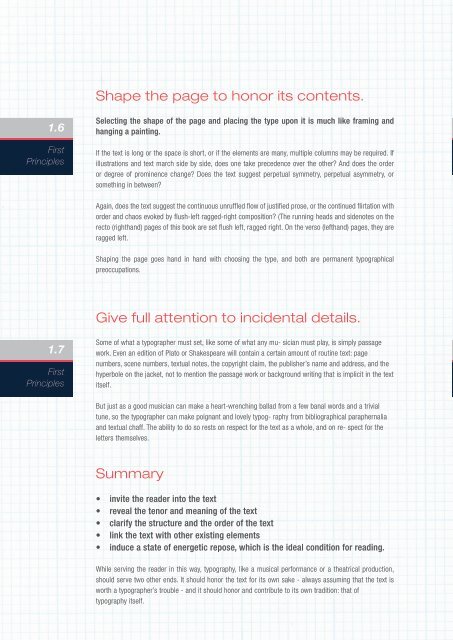5 Trick Pony Brand Guidelines v3
Create successful ePaper yourself
Turn your PDF publications into a flip-book with our unique Google optimized e-Paper software.
Shape the page to honor its contents.<br />
1.6<br />
First<br />
Principles<br />
Selecting the shape of the page and placing the type upon it is much like framing and<br />
hanging a painting.<br />
If the text is long or the space is short, or if the elements are many, multiple columns may be required. If<br />
illustrations and text march side by side, does one take precedence over the other? And does the order<br />
or degree of prominence change? Does the text suggest perpetual symmetry, perpetual asymmetry, or<br />
something in between?<br />
Again, does the text suggest the continuous unruffled flow of justified prose, or the continued flirtation with<br />
order and chaos evoked by flush-left ragged-right composition? (The running heads and sidenotes on the<br />
recto (righthand) pages of this book are set flush left, ragged right. On the verso (lefthand) pages, they are<br />
ragged left.<br />
Shaping the page goes hand in hand with choosing the type, and both are permanent typographical<br />
preoccupations.<br />
Give full attention to incidental details.<br />
1.7<br />
First<br />
Principles<br />
Some of what a typographer must set, like some of what any mu- sician must play, is simply passage<br />
work. Even an edition of Plato or Shakespeare will contain a certain amount of routine text: page<br />
numbers, scene numbers, textual notes, the copyright claim, the publisher’s name and address, and the<br />
hyperbole on the jacket, not to mention the passage work or background writing that is implicit in the text<br />
itself.<br />
But just as a good musician can make a heart-wrenching ballad from a few banal words and a trivial<br />
tune, so the typographer can make poignant and lovely typog- raphy from bibliographical paraphernalia<br />
and textual chaff. The ability to do so rests on respect for the text as a whole, and on re- spect for the<br />
letters themselves.<br />
Summary<br />
• invite the reader into the text<br />
• reveal the tenor and meaning of the text<br />
• clarify the structure and the order of the text<br />
• link the text with other existing elements<br />
• induce a state of energetic repose, which is the ideal condition for reading.<br />
While serving the reader in this way, typography, like a musical performance or a theatrical production,<br />
should serve two other ends. It should honor the text for its own sake - always assuming that the text is<br />
worth a typographer’s trouble - and it should honor and contribute to its own tradition: that of<br />
typography itself.





